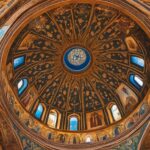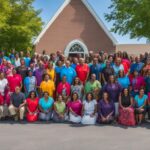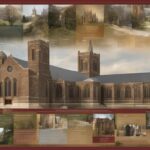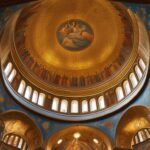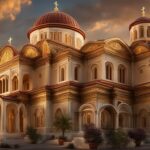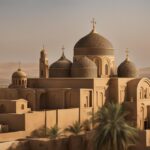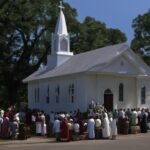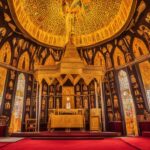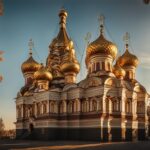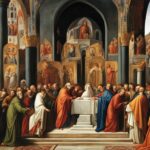The Syriac Orthodox Church is a venerable institution with a history that stretches back to the time of Jesus and his disciples. This ancient church, known for its Syriac Christianity and its use of the Syriac language in liturgy, has played a significant role in shaping the Christian tradition.
Founded by St. Peter the Apostle in the city of Antioch, the Syriac Orthodox Church prides itself on being the second established church in Christendom. Its Semitic form of Christianity and multiethnic nature have led to its widespread presence across Middle Eastern countries and the Indian State of Kerala.
In this article, we will delve into the origins and founders of the Syriac Orthodox Church, explore its key beliefs and doctrines, uncover its historical significance and denominational splits, discuss its leadership and governance, examine its worship practices, investigate its contemporary influence, and reveal its current world membership numbers and percentage among world religions.
Key Takeaways
- The Syriac Orthodox Church is one of the oldest apostolic churches, founded by St. Peter the Apostle.
- It embodies a unique Semitic form of Christianity and utilizes the Syriac language in its liturgy.
- The church has had a significant impact on the Christian tradition and experienced denominational splits.
- It is governed by a hierarchical structure led by the patriarch of Antioch.
- The Syriac Orthodox Church follows ancient and rich liturgical practices in its worship.
Origins and Founders of the Syriac Orthodox Church
The Syriac Orthodox Church traces its origins back to the time of the apostles, with St. Peter the Apostle establishing a bishopric in Antioch and becoming its first bishop. He was succeeded by Evodius, and from then on, the leadership of the church has been passed down through a line of distinguished patriarchs. Presently, the Syriac Orthodox Church is led by Patriarch Ignatius Ephram II Karim. The church’s founders also include St. Thomas, who established Christianity in India, and St. Bartholomew, who preached in Armenia. These early leaders played a significant role in shaping the beliefs and doctrines of the Syriac Orthodox Church.
The Syriac Orthodox Church, founded by St. Peter the Apostle himself, stands as a testament to the enduring faith and tradition of ancient Christianity. Its roots in Antioch and the influence of early apostles like St. Thomas and St. Bartholomew have shaped its distinctive character and beliefs. Through the centuries, the church has remained steadfast in its commitment to the Syriac Orthodox faith, carrying forward the teachings and traditions established by its founders.
The Syriac Orthodox Church leaders, known as patriarchs, have played a crucial role in the development and governance of the church. Their guidance and spiritual authority have shaped the course of the Syriac Orthodox faith over the centuries. Today, Patriarch Ignatius Ephram II Karim leads the church, ensuring the continuation of its traditions and the preservation of its rich heritage. The leadership and teachings of the founders and subsequent patriarchs have formed the foundation of the Syriac Orthodox Church, making it an integral part of the broader Christian tradition.
Table: List of Syriac Orthodox Church Patriarchs
| Patriarch | Time Period |
|---|---|
| St. Peter the Apostle | 1st century |
| Evodius | 1st century |
| Ignatius of Antioch | 1st-2nd century |
| St. Dioscorus I of Alexandria | 3rd-4th century |
| St. Severus of Antioch | 6th century |
| Ignatius Aphrem I Barsoum | 20th century |
| Ignatius Ephrem II Karim | 21st century |
Through the commitment and leadership of these patriarchs, the Syriac Orthodox Church continues to thrive and uphold its ancient faith, preserving its unique place within the tapestry of Christianity.
Key Beliefs and Doctrines of the Syriac Orthodox Church
The Syriac Orthodox Church holds to a set of key beliefs and doctrines that form the foundation of its faith. These beliefs are rooted in Orthodox Christianity, while also incorporating unique elements from the Syriac tradition.
One of the core beliefs of the Syriac Orthodox Church is the belief in the Holy Trinity. This doctrine holds that God exists in three persons: God the Father, God the Son (Jesus Christ), and God the Holy Spirit. The church also affirms the divinity and humanity of Jesus Christ, teaching that he is both fully God and fully human.
The church places a strong emphasis on sacraments, seeing them as essential channels of God’s grace. These sacraments include baptism, holy matrimony, ordination, the Eucharist, confession, anointing of the sick, and the sacrament of the Holy Leaven. The Syriac Orthodox Church also emphasizes the importance of prayer and the reading of scripture. The liturgy of the church, conducted in the Syriac language, is a central part of worship and is known for its ancient and rich ceremonial practices.
The Syriac Orthodox Church, with its unique blend of Orthodox Christianity and the Syriac tradition, offers a meaningful and deeply spiritual experience for its followers. Its emphasis on sacraments, prayer, and the Syriac liturgy provides a rich and vibrant expression of the Christian faith.
Table: Sacraments of the Syriac Orthodox Church
| Sacrament | Description |
|---|---|
| Baptism | The sacrament of initiation into the Christian faith, involving the pouring of water over the head of the individual. |
| Holy Matrimony | The sacrament of marriage, uniting a man and a woman in a sacred bond. |
| Ordination | The sacrament through which individuals are consecrated as clergy, such as deacons, priests, and bishops. |
| The Eucharist | The sacrament of the Lord’s Supper, in which bread and wine are consecrated and believed to become the body and blood of Jesus Christ. |
| Confession | The sacrament of repentance and forgiveness, in which individuals confess their sins to a priest. |
| Anointing of the Sick | The sacrament of healing and comfort for those who are ill or suffering. |
| The Holy Leaven | A sacramental element used in the preparation of the Eucharist, believed to have been brought by the apostle Thomas to India. |
The Syriac Orthodox Church’s unique blend of Orthodox Christianity and the Syriac tradition gives it a distinctive identity among Christian denominations. The Syriac tradition, seen in the use of the Syriac language in liturgy, connects the church to the ancient roots of Christianity, as Syriac is an Aramaic dialect similar to the language spoken by Jesus and the apostles. This linguistic connection enhances the church’s worship practices and offers a profound sense of continuity with the early Christian community.
To this day, the Syriac Orthodox Church continues to inspire and nourish its members with its rich liturgical traditions, vibrant faith, and commitment to the teachings of Jesus Christ. Its emphasis on the Holy Trinity, sacraments, prayer, and scripture reading provides a solid foundation for spiritual growth and a deepening of faith.
Historical Significance of the Syriac Orthodox Church
The Syriac Orthodox Church has played a significant role in the history of Christianity, particularly in the East. With its origins dating back to the time of Jesus and his disciples, the church emerged as a distinct community centered in Antioch and Edessa. It quickly spread throughout the region, attracting followers and establishing a strong presence in various Middle Eastern countries.
However, the church faced challenges and schisms along its historical trajectory. One significant event was the Council of Chalcedon in 451, which resulted in a split between the Chalcedonian and non-Chalcedonian churches. As one of the non-Chalcedonian churches, the Syriac Orthodox Church, along with the Coptic and Armenian Churches, rejected the council’s teachings, leading to the formation of a distinct branch of Christianity known as Oriental Orthodoxy.
This denominational split had far-reaching consequences and shaped the course of Christianity. The Syriac Orthodox Church, with its unique traditions and beliefs, has since maintained its identity as a prominent Oriental Orthodox Christian denomination, contributing to the rich diversity of Christian faith and practice worldwide.
The Schisms in the Syriac Orthodox Church
The history of the Syriac Orthodox Church is marked by various schisms and divisions, which have had a lasting impact on the denomination. These schisms arose from theological disagreements and power struggles, leading to the formation of different Syriac Orthodox factions.
One notable schism occurred in the 19th century with the emergence of the Malankara Orthodox Syrian Church in the Indian State of Kerala. This schism, known as the Malankara Church dispute, was a result of disputes over the administration and control of the church’s assets. The dispute was eventually resolved in the early 20th century, with the Malankara Orthodox Syrian Church becoming an autocephalous (self-governing) church within the Syriac Orthodox tradition.
| Denomination | Year of Schism |
|---|---|
| Chaldean Catholic Church | 1552 |
| Malankara Orthodox Syrian Church | 1889 |
| Mar Thoma Syrian Church | 1653 |
| Assyrian Church of the East | 431 (Nestorian Schism) |
The above table provides a glimpse of some of the major schisms and the corresponding years in which they occurred within the broader Syriac Christian tradition. These schisms have resulted in the formation of various distinct churches, each with its own unique identity and practices.
Leadership and Governance of the Syriac Orthodox Church
The Syriac Orthodox Church is structured with a hierarchical system of leadership and governance, with the patriarch of Antioch at its helm. The position of patriarch holds great significance in the church, as it is considered the successor of St. Peter, who founded the church in Antioch. The current patriarch is Ignatius Ephram II Karim, who has been leading the church since 2014.
Underneath the patriarch, the church has a synodal structure, where bishops and clergy serve as important figures. Bishops are responsible for overseeing specific regions and communities, ensuring the spiritual well-being of the members. The clergy, including priests and deacons, carry out the day-to-day religious rituals and provide guidance to the faithful.
In addition to the patriarchal leadership, the Syriac Orthodox Church also has its own local head in the Indian State of Kerala, known as the Catholicos of the East. This position serves as a focal point for the vibrant Syriac Orthodox Christian community in Kerala.

The hierarchical structure of the Syriac Orthodox Church ensures the smooth functioning and organization of the church, allowing for effective oversight and spiritual guidance. It also helps maintain the unity and coherence of the church as a whole, while allowing for regional autonomy and cultural variations within the faith.
“The Syriac Orthodox Church’s hierarchical structure provides a sense of stability and continuity, ensuring that the teachings and traditions of the church are upheld and passed down through generations.”
The patriarch of Antioch, along with the bishops, clergy, and other church leaders, plays a crucial role in preserving the ancient traditions and doctrines of the Syriac Orthodox Church. Their leadership and governance shape the direction of the church and guide its members in their spiritual journey.
Worship Practices of the Syriac Orthodox Church
The Syriac Orthodox Church is known for its rich and ancient liturgical tradition, which holds great significance in the worship practices of its members. The liturgy of the Syriac Orthodox Church is performed in the Syriac language, a Semitic language closely related to the Aramaic dialect spoken during the time of Jesus and the apostles. This utilization of the Syriac language adds a distinct cultural and historical dimension to the worship experience.
The Syriac Orthodox liturgy follows a structured order of worship, characterized by its solemnity, use of incense, and beautiful chants and melodies. The liturgy encompasses a range of elements, including prayers, hymns, scripture readings, and the celebration of the sacraments. It is a powerful and immersive experience that not only nourishes the spiritual life of the faithful but also connects them to the ancient traditions of their forefathers.
“The Syriac Orthodox liturgy is a spiritual journey that transports both the clergy and the congregation to a realm of divine beauty and transcendence. It is a time-honored practice that allows us to connect with our heritage and experience the presence of God in a profound and meaningful way.” – Rev. Isaac Abraham, Syriac Orthodox Priest
In addition to its regular liturgical practices, the Syriac Orthodox Church also observes the major feasts and fasts of the liturgical calendar. These include significant events such as Christmas, Easter, and Lent, which are commemorated with special services and rituals. These observances serve as opportunities for the faithful to deepen their spiritual connection with God and participate in the collective worship of the church.
| Key Elements of Syriac Orthodox Worship | Description |
|---|---|
| Prayers | The liturgy includes a variety of prayers, both prescribed and spontaneous, that express the faith, devotion, and intercession of the faithful. |
| Hymns | Chants and hymns are an integral part of the Syriac Orthodox liturgy, offering praise and adoration to God while enhancing the overall spiritual atmosphere. |
| Scripture Readings | The Holy Scriptures are read during the liturgy, providing spiritual nourishment and guidance for the congregation. |
| Sacraments | The celebration of sacraments, such as baptism and the Holy Eucharist, are central to the Syriac Orthodox worship experience and serve as conduits of God’s grace. |
The worship practices of the Syriac Orthodox Church reflect its deep-rooted traditions, cultural heritage, and commitment to the spiritual growth of its members. Through its liturgical expressions, the church seeks to create an environment where believers can encounter the divine and be transformed by the power of God’s presence.
Contemporary Influence of the Syriac Orthodox Church
The Syriac Orthodox Church continues to have a significant influence in the present day. As a member of the World Council of Churches and one of the founding members of the Middle East Council of Churches, it actively participates in ecumenical and theological dialogues with other Christian denominations. This engagement allows the church to contribute to the global Christian community by sharing its unique perspectives and insights.
“The Syriac Orthodox Church’s commitment to dialogue and cooperation with other churches is a testament to its desire for unity and understanding,” says Patriarch Ignatius Ephram II Karim. “Through these collaborative efforts, we strive to promote peace, justice, and reconciliation in our world.”
In addition to its involvement in inter-church relations, the Syriac Orthodox Church has a strong presence in diaspora communities around the world. Particularly in Europe and the Americas, the church serves as a spiritual and cultural center for Syriac Christians who have migrated from their ancestral homelands. These communities preserve and pass on the traditions, language, and liturgical practices of the Syriac Orthodox Church, ensuring its continuity and vitality.
Furthermore, the Syriac Orthodox Church’s influence extends beyond religious boundaries. It plays a significant role in preserving and promoting Syriac language, literature, and culture, which have deep historical roots in the region. Through educational initiatives, cultural events, and publications, the church actively fosters the appreciation and understanding of Syriac heritage among its members and the wider society.
Table: Syriac Orthodox Church’s Contemporary Influence
| Area of Influence | Examples of Impact |
|---|---|
| Inter-church Relations | Participation in ecumenical and theological dialogues |
| Diaspora Communities | Spiritual and cultural center for Syriac Christians around the world |
| Syriac Language and Culture | Preservation and promotion of Syriac language, literature, and heritage |
Through its contemporary influence, the Syriac Orthodox Church remains actively engaged in shaping and contributing to the diverse religious and cultural landscape of the present day.
Current World Membership Number and Percentage of World Religions
The Syriac Orthodox Church has a significant but relatively small number of members worldwide. While exact figures are difficult to ascertain, it is estimated that the church has several hundred thousand members globally. The majority of these members reside in Middle Eastern countries, particularly in Syria, Iraq, and Lebanon, where the church has its historical roots. Additionally, there is a substantial community of Syriac Orthodox Christians in the Indian State of Kerala, where the church has a strong presence.
When considering the percentage of world religions, the Syriac Orthodox Church represents a modest but meaningful portion of the global Christian population. While it may not have the same numerical strength as larger Christian denominations, its historical and cultural significance cannot be understated. The Syriac Orthodox Church’s adherence to its unique Semitic form of Christianity, its use of the Syriac language in liturgy, and its ancient liturgical practices contribute to its distinct identity within the broader Christian tradition.
To provide a visual representation of the current world membership number and its relative position among other major world religions, the following table presents estimated membership figures:
| Religion | Estimated Membership |
|---|---|
| Christianity | Over 2.3 billion |
| Islam | Over 1.8 billion |
| Hinduism | Around 1.2 billion |
| Buddhism | Around 500 million |
| Syriac Orthodox Church | Several hundred thousand |
Please note that these membership figures are approximate and vary depending on different sources and methodologies used for estimation. However, they provide an overview of the relative size of the Syriac Orthodox Church in comparison to other major world religions.
Conclusion
The Syriac Orthodox Church has a rich and vibrant history that spans centuries. From its origins in Antioch to its spread throughout the East and its influence in the present day, the church has played a vital role in shaping the Christian tradition. The church’s unique Semitic form of Christianity, its use of the Syriac language, and its emphasis on ancient liturgical practices make it a distinct and vibrant member of the global Christian community.
Throughout its history, the Syriac Orthodox Church has faced challenges and schisms, particularly after the Council of Chalcedon in 451. However, it has remained steadfast in its beliefs and doctrines, holding to the basic tenets of Orthodox Christianity. The church places a strong emphasis on sacraments, prayer, and the reading of scripture, and its liturgy is known for its solemnity and beauty.
In the present day, the Syriac Orthodox Church continues to have a significant influence. It is actively involved in ecumenical and theological dialogues with other Christian denominations, and it has a strong presence in diaspora communities around the world. While the exact number of church members is difficult to determine, it is estimated to have several hundred thousand followers worldwide, representing a small but significant portion of the global Christian population.
The history of the Syriac Orthodox Church is a testament to the enduring legacy of early Christianity and the rich tapestry of faith and culture that it has preserved. As the church continues to thrive and adapt in the modern world, it remains a beacon of hope and a symbol of unity for its followers.
FAQ
What is the history of the Syriac Orthodox Church?
The Syriac Orthodox Church has its origins dating back to the time of Jesus and his disciples. It is one of the oldest established apostolic churches in Christianity and prides itself on being the second established church after Jerusalem.
Who founded the Syriac Orthodox Church?
The Syriac Orthodox Church was founded by St. Peter the Apostle, with its roots deeply tied to the city of Antioch.
What are the key beliefs and doctrines of the Syriac Orthodox Church?
The Syriac Orthodox Church holds to the basic tenets of Orthodox Christianity, including the belief in the Holy Trinity and the divinity and humanity of Jesus Christ. It emphasizes the importance of sacraments, prayer, and the reading of scripture. It also places a strong emphasis on the Syriac tradition and uses the Syriac language in its liturgy.
What is the historical significance of the Syriac Orthodox Church?
The Syriac Orthodox Church emerged as a distinct community in the East, spread rapidly throughout the region, and played a significant role in shaping the beliefs and doctrines of Christianity. It faced challenges and schisms, particularly after the Council of Chalcedon, which led to a split between the Chalcedonian and non-Chalcedonian churches.
How is the Syriac Orthodox Church governed?
The Syriac Orthodox Church is governed by a hierarchical structure led by the patriarch of Antioch. It has a synodal system of governance, with bishops and clergy serving under the leadership of the patriarch.
What are the worship practices of the Syriac Orthodox Church?
The Syriac Orthodox Church has a rich and ancient liturgical tradition. The liturgy is performed in the Syriac language and follows a structured order of worship. It includes prayers, hymns, scripture readings, and the celebration of the sacraments.
What is the contemporary influence of the Syriac Orthodox Church?
The Syriac Orthodox Church is a member of the World Council of Churches and participates in ecumenical and theological dialogues with other Christian denominations. It also has a strong presence in diaspora communities around the world.
How many members does the Syriac Orthodox Church have?
The exact number of current members is difficult to determine, but it is estimated that the Syriac Orthodox Church has several hundred thousand members worldwide.
What is the conclusion regarding the history of the Syriac Orthodox Church?
The history of the Syriac Orthodox Church is a testament to the enduring legacy of early Christianity and its unique Semitic form of Christianity, use of the Syriac language, and emphasis on ancient liturgical practices.

